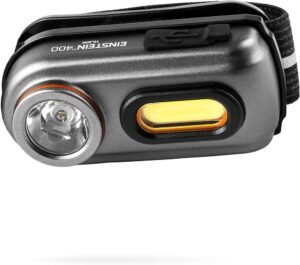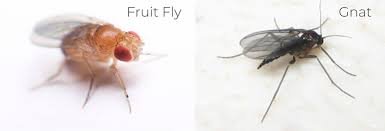Image Credit: Kapture Pest Control
Tiny flying pests buzzing around your home can be more than just a nuisance. When it comes to gnats vs fruit flies, many people struggle to tell these common household insects apart. Both can invade living spaces, contaminate food, and cause frustration for homeowners. Understanding the differences between these tiny flies is crucial for effective pest control and maintaining a clean, comfortable environment.
This article will explore the key distinctions between gnats and fruit flies, including their physical characteristics, preferred habitats, and breeding grounds. It will also provide practical tips for identifying these insects and implementing targeted control measures. By learning about their body types, typical behaviors, and attraction to substances like apple cider vinegar, readers will gain valuable knowledge to address infestations in houseplants, drains, and other problem areas around the home.
Physical Characteristics of Gnats and Fruit Flies
Appearance of Gnats
Gnats are very small insects, typically measuring between 1/16 and 1/8 of an inch in length. They have slender black bodies and translucent wings with visible veining. When not in flight, gnats usually fold their wings behind their backs. These tiny insects possess six legs and moderately long antennae. Fungus gnats, a common variety, have a dark gray to black coloration and feature dangling legs and elongated bodies, giving them a resemblance to miniature mosquitoes. Their heads and eyes are small, often difficult to see without magnification.
Appearance of Fruit Flies
Fruit flies are slightly larger than gnats, with adults growing to about 1/8 of an inch in length. They have an oval shape and a rounded silhouette, resembling a miniature version of a common housefly. Their thorax is typically tan in color, while their abdomen is black with a gray underbelly. Overall, fruit flies tend to have a tan to brownish appearance. One of the most distinctive features of fruit flies is their large, red eyes, although some species may have dark-colored eyes. Their antennae are adorned with feathery bristles.
Key Differences
The primary distinctions between gnats and fruit flies lie in their body shape, coloration, and eye size. Gnats have more slender, elongated bodies compared to the rounder shape of fruit flies. While gnats are predominantly dark gray or black, fruit flies range from tan to almost black, with a generally lighter appearance. Fruit flies are easily recognizable by their large, often red eyes, whereas gnat eyes are much smaller and harder to see.
Another notable difference is in their wing structure and positioning. Fruit flies have transparent wings that extend past their backside and overlap when at rest. In contrast, gnat wings are translucent with visible veining and fold behind their back when not in use.
These physical characteristics play a crucial role in identifying these common household pests, allowing for more effective control measures to be implemented based on the specific type of insect present.
Habitat and Breeding Grounds
Gnat Habitats
Gnats thrive in warm, moist environments rich in decaying organic matter. These tiny insects can be found on every continent except Antarctica, with a preference for areas like forest floors, swamps, and densely landscaped backyards. Indoor environments also provide suitable habitats for gnats, particularly in areas with high humidity and organic debris.
Potted houseplants are a common breeding ground for fungus gnats, as the moist soil provides an ideal environment for their larvae. Other indoor locations where gnats may establish themselves include drainage systems, sewer lines, and areas with water damage such as crawl spaces, attics, or damp walls. Commercial settings like nurseries and greenhouses also contend with gnat infestations due to the abundance of plants and moisture.
Fruit Fly Habitats
Fruit flies, as their name suggests, are primarily attracted to ripening or fermenting fruits and vegetables. They are commonly found both indoors and outdoors, with their presence often more noticeable during late summer and fall when fruits are abundant. Inside homes, fruit flies hover around trash cans, recycling bins, and areas where fruits and vegetables are stored.
These insects are also drawn to alcoholic beverages, making them a common nuisance in bars and restaurants. Outdoors, fruit flies frequently inhabit fruit trees and vegetable gardens, where they can access their preferred food sources.
Common Breeding Areas
Both gnats and fruit flies require moist environments with organic matter to reproduce. Some shared breeding grounds include:
- Drains and garbage disposals
- Moist areas under kitchen appliances
- Overripe fruits and vegetables
- Compost piles and mulch
- Dirty mops and cleaning equipment
- Recycling bins with unrinsed containers
- Floor cracks and crevices in kitchens
- Potted plants with overly moist soil
Female gnats can lay up to 500 eggs in their lifetime, depositing them in small batches of about 30 on rotting organic matter. These eggs hatch in less than a week, with larvae developing through a pupa stage over approximately three weeks. Fruit flies have a similar life cycle, with eggs laid near the surface of fermenting foods or other moist, organic materials.
To prevent infestations, it’s crucial to eliminate potential breeding sites by maintaining cleanliness, properly storing food, and addressing moisture issues in and around the home. Regular inspection and cleaning of drains, garbage areas, and plant containers can significantly reduce the likelihood of gnat and fruit fly problems.
Identification Methods
Visual Inspection
Identifying gnats and fruit flies becomes easier once one knows what to look for. Fruit flies resemble miniature house flies, with a chunky, sturdy shape and brown coloration. They typically measure about ⅛-inch long, with red-eyed varieties being slightly smaller than dark-eyed ones. Their most distinctive feature is their large eyes, which are either red or black, depending on the species. Fruit flies also have striped abdomens, adding to their unique appearance.
Gnats, on the other hand, have a more delicate form, resembling tiny mosquitoes. They are usually black or dark gray with light-colored legs and measure less than ⅛-inch in length. Their eyes are small and difficult to see without magnification. Drain flies, a type of gnat, have a unique appearance with light gray or tan bodies, fuzzy exteriors, and dark-bordered wings, giving them a moth-like appearance.
Behavior Patterns
Observing behavior patterns can help distinguish between these pests. Fruit flies typically hover around fruit bowls, trash receptacles, recycling bins, and drains or garbage disposals. They are particularly attracted to fermented foods, overripe fruits, and alcoholic beverages.
Fungus gnats exhibit different behavior, often flying close to potted plants and showing little interest in other areas. They prefer moist soil, which protects their larvae as they develop. Drain flies, as their name suggests, breed inside drains and can be seen clumsily flying out and landing on nearby walls and ceilings.
Using Traps
Traps can be an effective method for identifying and controlling these pests. For fruit flies, using attractants such as overripe fruits, beer, wine, or vinegar can lure them into traps. These traps are most effective when placed in the kitchen, where fruit flies are commonly found.
For gnats, traps placed near potted plants or damp areas can help identify their presence. Since gnats have a varied diet, including mold and blood, traps may need to be placed in different locations throughout the home. Addressing moisture issues and inspecting organic materials brought into the home, such as potted plants, can help prevent gnat infestations.
Conclusion
Understanding the differences between gnats and fruit flies is key to dealing with these pesky insects effectively. Their distinct physical features, preferred habitats, and behaviors provide valuable clues for homeowners to identify and tackle infestations. By knowing what to look for and where these pests are likely to breed, you can take targeted steps to prevent and control their presence in your living spaces.
Maintaining a clean environment and addressing moisture issues are crucial to keeping both gnats and fruit flies at bay. Regular cleaning, proper food storage, and monitoring of potential breeding sites can go a long way in preventing these tiny flies from becoming a nuisance. With the right knowledge and approach, you can create a more comfortable and pest-free home environment, ensuring that these small but persistent insects don’t bug you or your family.
FAQs
Q: How can I tell whether I’m dealing with gnats or fruit flies in my home?
A: To differentiate between gnats and fruit flies, pay attention to their behaviors and the locations they frequent in your home. Fruit flies are commonly found around kitchen counters and trash bins due to the presence of food, whereas gnats are more likely to be found in damp areas not limited to the kitchen.
Q: What is the most effective method to eliminate gnats and fruit flies?
A: The optimal approach to control gnats and fruit flies involves a combination of sanitation, reducing moisture, and using traps. Regularly disposing of garbage and cleaning up food residues can significantly reduce their populations.
Q: What is the quickest way to get rid of fruit flies?
A: For a rapid solution to fruit fly problems, you can create a DIY trap using vinegar and dish soap. Mix a quarter cup of apple cider vinegar or white vinegar with a few drops of dish soap in a container. The vinegar attracts the fruit flies, and the dish soap causes them to drown by breaking the surface tension of the vinegar.
Q: How can I quickly eliminate gnats inside my house?
A: To quickly get rid of gnats, you can use several methods:
- Employ a bug zapper.
- Set up a vinegar trap by mixing vinegar with dish soap.
- Apply a spray solution directly to the gnats.
- Pour boiling water down drains to destroy larvae.
- Use beer or wine as bait in a trap.
- Place sticky traps around your home.
- Purchase a natural gnat trap.
- Create a candle trap to attract and capture gnats.
























[…] […]
[…] Read More About: Gnats vs Fruit Flies […]